Lutherie Library
SIMSCal has a collection of books, videos, and other materials related to instrument building, available for check-out by our dues-paying members. Library materials can be requested by emailing info@simscal.com, or in-person at one of our meetings or events. Materials must be picked up in-person at one of our meetings or events, or by arranging an appointment with the SIMSCal Librarian or other SIMSCal board member; we do not mail out library materials. Please aim to return materials by the next scheduled meeting (usually about 2 – 3 months), to give all members a fair chance of checking out materials.
Materials are listed alphabetically by title. Big thanks to member Michael Hersh for cataloging all of these materials.
A
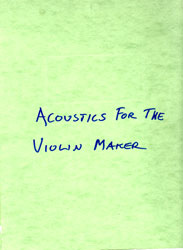
Acoustics for the Violin Maker
by Catgut Acoustical Society
Various authors on technical aspects of the craft; simply bound photocopied, pages not consecutively numbered, approximately 300 pages. Published 1978. *Donated by the Southern California Association of Violin Makers (SCAVM).
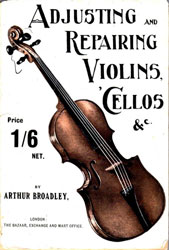
Adjusting and Repairing Violins, ‘Cellos, et cetera
by Arthur Broadley
Though subtitled “A Practical Handbook for All Players,” this is more of an illustrated diary than a true, researched publication on the subject. There is little useful technical information present, even for the novice, and it is presented here mainly for its historical/cultural value. In poor shape; separated cover. 80 pages. Published 1923. *Donated by the Southern California Association of Violin Makers (SCAVM).

The Amadeus Book of the Violin: Construction, History, and Music
by Walter Kolneder
Since 1972, this encyclopedic volume on the construction, history, and lore of the violin has been an important resource. Now translated into English for the first time and brought further up-to-date by referencing material as recent as 1996. Kolneder, the late Austrian conductor and musicologist, divided his massive tome into three parts. The first, which deals with the physical instrument itself, contains detailed information on such diverse topics as bow-making, varnish, worm and crack damage, and string acoustics. This part, by necessity somewhat dry and pedantic, is followed by a remarkably inclusive history of the violin, most impressive in its detailed examination of the various regional and national schools of violin-making throughout the world. The third part, titled “Performance, Pedagogy, and Composition,” may be the most ambitious in scope; the section on virtuosi alone is worth the price. Amadeus Press. 597 pages, hardcover. Published 1993. English edition published 1998. *Donated by the Southern California Association of Violin Makers (SCAVM).
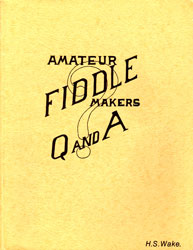
Amateur Fiddle Makers Q and A
by H.S. Wake
Mr. Wake’s useful, thorough, informative, and easy-to-understand answers are given to the most generally asked questions from amateur fiddle makers. Includes sketches, helpful hints, and more on the secrets of the masters. 47 pages, soft cover. Published 1980. *Donated by the Southern California Association of Violin Makers (SCAVM).
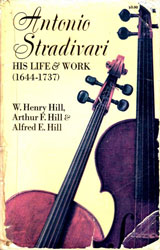
Antonio Stradivari: His Life & Work (1644-1737)
by W. Henry Hill, Arthur F. Hill & Alfred E. Hill
It is strange, but true, that only one book really delves into the life and art of this famous Italian craftsman. That is the book published in 1902 by the three Hill brothers of the London violin-making firm. Expert violin-makers and critics of superior violin craftsmanship, these men had unique opportunities to examine and compare almost all of the great examples of Italian violin-making. The larger divisions of the book concern the ancestry of Stradivari; his violins, viols, and violoncellos; his aims in relation to tone; his materials; his varnish; his construction; his labels; the number of instruments he made; the growth of their reputation. Some of the topics discussed under these main headings are: Stradivari’s apprenticeship to Amati; comparison of his work with that of Amati; the tone of the pre-1684 Stradivari violin; changes between 1684 and 1690; distinguishing characteristics of many existing violins, violas, and cellos, their specific location, etc.; erroneous views concerning Stradivari’s material; his preference for the wood of certain trees in given years; the mystery of the ingredients of Stradivari’s varnish; the effect of varnish on tone; the measurements of Stradivari’s instruments; the time spent by Stradivari in making a violin; the years of greatest production; the largest number dating from one year; estimate of the total number made; an estimate of the actual sum he charged for an instrument; the introduction of Stradivari instruments into France and England; the first revelation of their supreme merit; and many other interesting topics. 315 pgs, softcover. Published 1963. *Donated by the Southern California Association of Violin Makers (SCAVM).
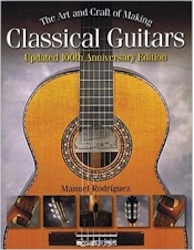
The Art and Craft of Making Classical Guitars
by Manuel Rodriguez
Rich in beauty, sound, and history, Manuel Rodriguez and Sons’ classical and flamenco guitars have been handcrafted in Madrid since 1909, and the company’s creations are still acclaimed today. This book presents master luthier Manuel Rodriguez’s thoughts on the history of the instrument he loved, including how the guitar attained its prominent position among musical instruments. Filled with fabulous historical photos, memorabilia, and more, this book is essential for all admirers of the guitar. 176 pages. Published 2009.
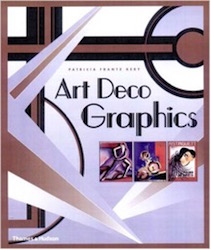
Art Deco Graphics
by Patricia Frantz Kery
Comprehensive survey on the dynamic graphic design in the three decades before World War II, when economic and political upheaval mixed with a wild pursuit of gaiety, luxury, modernism and elegance to produce a style known variously as Modern, Skyscraper, Jazz Style and, eventually, Art Deco. There are chapters on posters, magazines, commercial design, books, fashion and costume, each with an illustrated introductory text followed by a portfolio of illustrations of works that range from the established masterpieces of Art Deco to never-before-reproduced pieces found in Europe, Latin America, the United States and Japan. 319 pages. Published 2002.
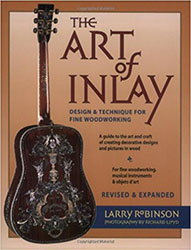
The Art of Inlay: Design & Technique For Fine Woodworking
by Larry Robinson
This dazzling showcase of the art of inlay provides artistic inspiration as well as how-to instruction and design insights written by the inlay artist for U2, Led Zeppelin, and many more. Over 100 color photographs show you exquisite inlays in musical instruments, wooden boxes, and various objets d’art, while black-and-white photos and drawings guide you through the intricate process of creating your own. The book has been revised and expanded throughout, including an additional 16-page gallery of inlay examples. 128 pages. Published 2005.
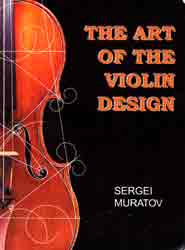
The Art of the Violin Design
by Sergei Muratov
Geometric analysis of violin shapes. 136 pages, softcover, oversize. Published 2002. *Donated by the Southern California Association of Violin Makers (SCAVM).
B
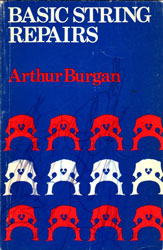
Basic String Repairs
by Arthur Burgan
A Guide to minor repairs by an English expert. Oxford University Press. 70 pages, softcover. Published 1981. *Donated by the Southern California Association of Violin Makers (SCAVM).
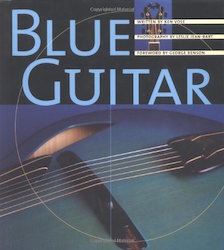
Blue Guitar
by Ken Vose
After acquiring over 1,000 guitars, collector Scott Chinery bought one that refueled his passion for the instrument. It was an 18-inch archtop guitar designed by Jimmy D’Aquisto. D’Aquisto finished off his creation with a blue sunburst design that inspired its new owner to commission a series of blue guitars because “blue just seemed the perfect color to jolt people out of the old, staid, traditional way of looking at the archtop.” Chinery tracked down 22 of the world’s finest luthiers, sent them each a bottle of Ultra Blue Penetrating Stain #M 520, and told them to make the archtop guitar of their dreams. The results are as beautiful as they are varied. A solid history of the evolution of the archtop and anecdotes about guitar making by the featured luthiers help expand readers’ appreciation of the craft and are a real treat for guitar lovers. 132 pages. Published 1998.
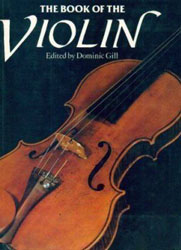
The Book of the Violin
edited by Dominic Gill
This book, written by a team of distinguished craftsmen, historians and critics, covers the history and the making of violins and bows, the history and repertoire to the present day, violin technique, the folk fiddle, the great virtuosos and historic recordings. Illustrated throughout with 240 plates, including 60 in color. 256 pages, hardcover. Published 1984. *Donated by the Southern California Association of Violin Makers (SCAVM).
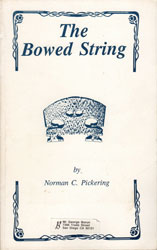
The Bowed String
by Norman C. Pickering
Examines requirements for gut strings and bows, study of tonal effects. 132 pages, paperback. Published 1991. *Donated by the Southern California Association of Violin Makers (SCAVM).

Bow Making: 1000 Bows and a Tribute
by John Alfred Bolander
Short pamphlet on making bows for violin family instruments. 37 pages. Published 1982. *Donated by the Southern California Association of Violin Makers (SCAVM).
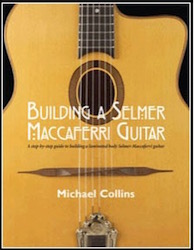
Building A Selmer Maccaferri Guitar: A Step-By-Step Guide To Building A Laminated Body Selmer-Maccaferri Guitar
by Michael Collins
This book details the step-by-step construction of the laminated European style Jazz guitar, made famous by the great gypsy jazz guitarist, Django Reinhardt. Topics covered include: Wood • Gluing the Body • Tools • Binding • Sharpening • The Fingerboard • Molds • The Neck • Lamination • Finishing • Rim Assembly • Bridge • Liners • Hardware • Bracing the Back • Set-up • The Soundboard • Pickups. From producing the “pliage,” to inlaying the rosette, preparing the laminate, carving the neck, to applying the finish, each topic is discussed in great detail. Construction techniques for both the short-scale D-hole instrument and the long-scale Oval-hole guitar are covered. Over 275 photographs and 75 diagrams positioned throughout the text to help even the novice builder understand and complete each process. 288 pages. Published 2006. *Donated by Jim Ellsberry.
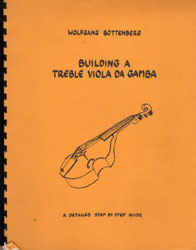
Building a Treble Viola Da Gamba: A Detailed Step-by-Step Guide
by Wolfgang Bottenberg
Spiral bound. Concordia University Press. 65 pages. Published 1980. *Donated by the Southern California Association of Violin Makers (SCAVM).

Building the Herringbone Guitar Kit (VHS cassette)
with Dan Erlewine
Build-along instructional video that was once included with Stewart-MacDonald’s Herringbone (i.e. Dreadnought) acoustic guitar kit. 84 minutes. Produced in 1988.
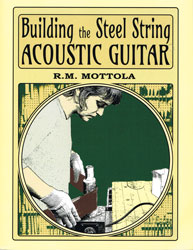
Building the Steel String Acoustic Guitar
by R.M. Mottola
The result of over twenty years of research to identify, catalog, and assess acoustic guitar construction techniques, Building the Steel String Acoustic Guitar is the most comprehensive source of steel string guitar construction information available. Designed specifically to be accessible to the first-time guitar builder, information is presented as a series of small and well-defined construction operations. Historical information and background theory is provided where appropriate for each of these operations. Construction is presented using tools that most woodworkers already have, supplemented by a minimal set of special-purpose guitar-making tools. The construction techniques make heavy use of simple jigs and fixtures which help achieve precision results. Guitar construction operations that novice builders find to be difficult and confusing are broken down into easy-to-understand parts and are explained in step-by-step detail. Commonly made construction mistakes are pointed out, along with instructions for fixing them. Important details of construction that may not be obvious to first time guitar makers are carefully described. 503 pages, paperback. Published 2021. *Donated by the author, R.M. Mottola.
C
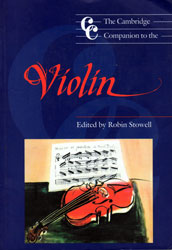
The Cambridge Companion to the Violin
edited by Robin Stowell
The Cambridge Companion to the Violin offers students, performers and scholars a fascinating and composite survey of the history and repertory of the instrument from its origins to the present day. The volume comprises fifteen essays, written by a team of ten specialists, and is intended to develop the violin’s historical perspective in breadth from every relevant angle. The main subjects discussed include the instrument’s structure and development; its fundamental acoustical properties; principal exponents; technique and teaching methods; solo and ensemble repertory; pedagogical literature; traditions in folk music and jazz; and aspects of historical performing practice. The text is supported by numerous illustrations and diagrams as well as music examples, a useful appendix, glossary of technical terms and an extensive bibliography. 303 pages, paperback. Published 1992, reprinted 1995. *Donated by the Southern California Association of Violin Makers (SCAVM).
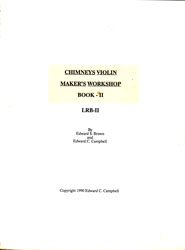
Chimney’s Violin Makers Workshop, Book II
by Edward S. Brown
Workshop/group study material. Published 1990. *Donated by the Southern California Association of Violin Makers (SCAVM).

Classic Guitar Construction
by Irving Sloane
Clear and easy to follow for the home craftsman, the beginning guitar student and the amateur guitar-maker, this authoritative workbook will be of value even to the master craftsman, as it reveals the subtle arts of the the luthier and the solution to each problem. Packed with excellent photos and diagrams, the book covers everything the home craftsman needs to know in order to construct a fine instrument that will produce a brilliant, balanced tone over its entire range, and whose action, craftsmanship and finish make it a unique pleasure to play. Sloane discusses materials, forms, processes, finishing, tools, techniques and assembly, all with careful, fully detailed step-by-step instructions and illustrations that leave nothing to the imagination. 95 pages. Published 1970.
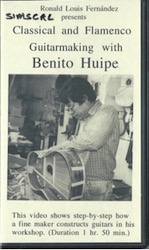
Classical and Flamenco Guitarmaking with Benito Huipe (VHS cassette)
by Ronald Louis Fernández
Want to see and learn how classical guitars are really made? Then this video is for you! In it Benito Huipe openly shares how to make guitars in the traditional Spanish method—with the integrated neck-body construction. And Ron Fernández, who taped Benito’s work, provides commentary which demystifies the art of guitarmaking. This is an in-depth, hands-on record of making guitars from start to finish. 110 minutes. Produced in 1994.
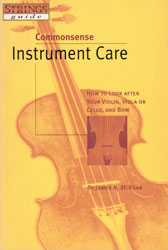
Commonsense Instrument Care: How to Look after your Violin, Viola or Cello, and Bow
by James N. McKean
This guide is a must-have reference book to help all violin, viola and cello owners care for their instruments and bows. With education and guidance, any player can learn: what is necessary to get a stringed instrument into top condition for optimum sound and tone; routine maintenance practices; how to treat an instrument to ensure that it will provide a lifetime of quality playing and musical enjoyment; and much more. Includes helpful photos throughout. Hal Leonard. 64 pages, paperback. Published 1996. *Donated by the Southern California Association of Violin Makers (SCAVM).
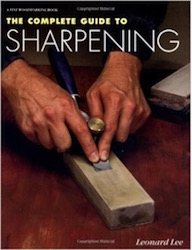
The Complete Guide to Sharpening
by Leonard Lee
Lee, a well-known tool manufacturer, covers the practical and technical information to sharpen tools quickly, efficiently and safely. Descriptive photos, clear line drawings and step-by-step instructions show exactly how to improve the performance and safety of any cutting tool. 256 pages. Published 1996.
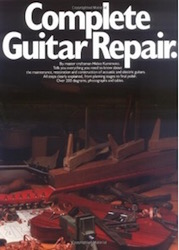
Complete Guitar Repair
by Hideo Kamimoto
If you aim to restore or construct a guitar, electric or acoustic, this book will show you how. Written in easy to follow language, it has—among others—valuable chapters on Guitar Construction, General Repair Information, Action and Scale Length, The Neck and Fingerboard, and The Bridge. It deals with such important subjects as repairing cracks and missing sections, loose braces, touchup methods, finishes, spray techniques, final rub and polish. In fact, this book contains everything you want to know about caring for or constructing guitars—including classical and flamenco guitars. There are even special sections on the unique problems of electric guitars and how to buy a guitar. Throughout the book, every important point is illustrated by diagrams, photographs and tables… over 200 in all. You are never left in doubt about exactly what you have to do. Whether you are a guitarist, music store salesperson, collector or repairman, this is one book which must be in your library. 160 pages. Published 1992. *Donated by Jim Ellsberry.
D

Django Reinhardt and the Illustrated History of Gypsy Jazz
by Michael Dregni
Django Reinhardt was perhaps the greatest guitarist to ever live. A Gypsy who made his jazz guitar speak with a human voice, he was dashing, charismatic, childish… and doomed to die young after creating a legacy of Gypsy Jazz that remains vibrant today. 208 pages. Published 2006. *Donated by Jim Ellsberry.
E
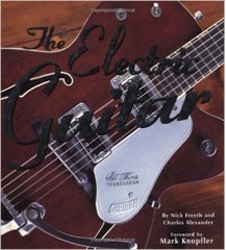
The Electric Guitar
by Nick Freeth and Charles Alexander
A comprehensive, authoritative, and visually dynamic compilation, The Electric Guitar traces the achievements of Leo Fender, Llyod Loar, and Les Paul, and examines developments in electric guitar technology, amplification, and electronic effects. Features more than 200 full-color photographs highlighting instruments and equipment from every period of the electric guitar’s history. 160 pages. Published 2000.
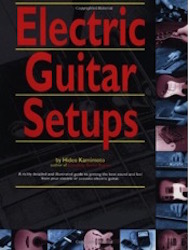
Electric Guitar Setups
by Hideo Kamimoto
The ins and outs of today’s elaborate guitar hardware are examined in this book, with complete instructions on adjusting and tweaking your electric guitar setup. It serves as a guide to getting the best sound and feel from the electric or acoustic-electric guitar. Over 120 charts and illustrations will help you in achieving that perfect sound. 88 pages. Published 1993. *Donated by Jim Ellsberry

Electric Guitars: The Illustrated Encyclopedia
by Tony Bacon
From the award winning team that produced the best selling Ultimate Guitar Book comes the most comprehensive book about the electric guitar. Its A-to-Z format covers more than 120 makers from around the world and details their successes and failures through 1,200 unique color, studio quality photographs. The book focuses on the iconic electric guitar with an introduction that places the electric guitar in a historical context, running from early acoustic instruments in the 16th century to amplification experiments in the 1930’s. The main body of the book is the A-to-Z of brands, covering the key 65-year period from 1935 to 2000. 318 pages. Published 2000.
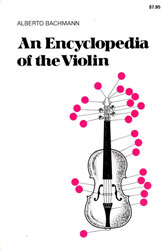
An Encyclopedia of the Violin
by Alberto Bachmann
Swiss-born Alberto Bachmann was a concert violinist and composer whose enthusiasm for the instrument compelled him to write about it. He wrote Le Violon in 1906, Les Grands Violinistes du Passé in 1913, Gymnastique à l’Usage des Violinistes in 1914, and culminated his work as a writer in 1925 with the publication of this encyclopedia. Da Capo Press. 470 pages, softcover. Published 1925, reprinted 1978. *Donated by the Southern California Association of Violin Makers (SCAVM).
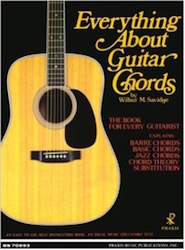
Everything About Guitar Chords
by Wilbur M. Savidge
Everything About Guitar Chords is: a scale position book • a scale theory book • a mode position book • a mode theory book. This self-instruction book explains barre chords, basic chords, jazz chords, chord theory, and substitution. It covers everything any guitarist needs to know about chords! Scale fingerings and patterns presented. For beginners, teachers and advanced players. 192 pages. Published 1992. *Donated by Jim Ellsberry.
F
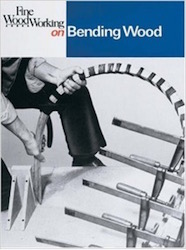
Fine Woodworking on Bending Wood
by the Editors of Fine Woodworking
Whether making a delicate violin, a pair of skis or a graceful armchair, you’ll need to bend wood. This text presents the basic methods and trade secrets from the experts. There are 35 articles in all, including “Hot Pipe Bending” by William Cumpiano, co-author of Guitarmaking: Tradition and Technology. 122 pages. Published 1989.
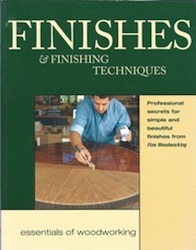
Finishes & Finishing Techniques: Professional Secrets for Simple and Beautiful Finishes
by the Editors of Fine Woodworking
This volume will enable you to get pro-quality finishes every time. Each type of finish and technique is presented in a clear and accessible way. You’ll get complete coverage of smoothing and preparing surfaces, changing the color of wood with dyes, pigments, and stains, polishing finishes to a high gloss, spray finishing, and repairing damaged finishes. Some of the finishes are just about foolproof. All finishes in Finishes & Finishing Techniques offer professional-looking results. In 33 articles, experts address: Surface preparation • Coloring wood • Hand finishing • Spray finishing • Water-based finishes • Special techniques. 208 pages. Published 1999.
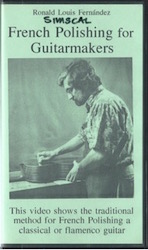
French Polishing for Guitarmakers (VHS cassette)
by Ronald Louis Fernández
French Polishing is a method for applying spirit varnish by hand—it is the traditional finish of master Spanish guitarmakers. The basic technique uses only shellac, alcohol, pumice, oil and a special rubbing pad. It is simple in theory but often tricky in practice. In this step-by-step presentation, the complete process is shown from preparing the guitar through sealing, filling, loading and clearing. Special advice on materials and practical techniques is included throughout. In addition, 2 printed charts are enclosed with this video. They explain how materials are used during each stage of the process and also suggest a typical work schedule. This video should enable you to create a fine finish and to understand the Art of French Polishing. 53 minutes. Produced in 1995.

The Fretboard Journal, No. 5, Spring 2007
Occasional Publishing, Inc.
Articles on: Tony Rice’s Martin D-28 • Charles Fox’s Ergo guitars • Bill Kitchen, Telecaster master • How to age electric guitars. 128 pages. Published 2007.
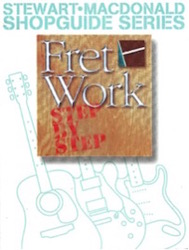
Fret Work Step-by-Step: Stewart-MacDonald Shopguide Series (1st Edition)
by Dan Erlewine
This book answers the hundreds of questions the author received about fretting. It covers the fretting of four guitars and shows a simple fret-dressing on a fifth. Each instrument starts from scratch, and many of the procedures are repeated; but each has its own unique twist because, since no two necks react alike, every fret job is different. 125 pages. Published 1994. *Donated by Jim Ellsberry.
G
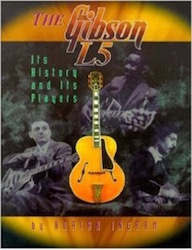
The Gibson L5: Its History and its Players
by Adrian Ingram
Introduced in 1922, the Gibson L5 is the precursor of the modern archtop guitar. It was the first archtop to feature f-holes, which allowed it to project through the horn-dominated bands of the day. Its strong, full, warm sound was an immediate and overwhelming success that turned the heads of makers, players and listeners alike. This book takes a look at its history and most famous players, from its creation, through the Norlin years, to its standing today as the world’s most popular jazz guitar. With its stunning 16-page full-color photo section, this book is a must for every guitar enthusiast’s collection! 112 pages. Published 1997. *Donated by Jim Ellsberry.
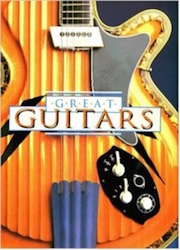
Great Guitars
by Robert Shaw
In Great Guitars, Shaw selects more than 50 of the most beautiful and influential guitars and looks at them both in terms of their musical importance as well as works of superb craftsmanship in their own right. Full-page color reproductions, from old favorites to just-completed, never-before-seen masterpieces, make this the perfect book for any guitar lover. 117 pages. Published 1998.

Great Masters of the Violin: From Corelli and Vivaldi to Stern, Zukerman and Perlman
by Boris Schwarz
This is a thorough account of history of the violin and its masters. Chapters on early masters are especially impressive, with more than sufficient information and fair analysis on each artist. The simplistic, yet comprehensive and highly informative writing style of Mr. Schwartz make it a more enjoyable reading; anyone, even with minimal knowledge on violin, will find it accessible and pleasant to read. Not a single line in this book is boring, or pedantic; a personal tribute/anecdote at the end of each chapter on modern violinists is often moving with the author’s candor and endearing admiration for the artist. Simon & Schuster. 671 pages, hardcover. Published 1983. *Donated by the Southern California Association of Violin Makers.
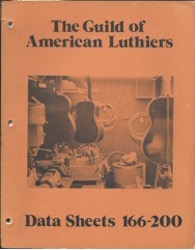
The Guild of American Luthiers: Data Sheets 166-200
Various Authors
A collection of technical articles written by members of The Guild of American Luthiers, in the early days before the guild switched to the magazine format of American Lutherie. Data sheets presented here include: 166. Computer Fret Spacing, Part 2 • 167. Making Aluminum Clamps • 168. Heat Sink Clamp • 169. Two Production Machines • 170. Arched Top Carving Gauge • 171. Soundboard Bracing Considerations • 172. Improved X-Bracing • 173. Systems Analysis of the Violin • 174. White, Yellow & Hide Glues • 175. The Parisian Eye • 176. Fitting Lute Pegs • 177. Misc. #10: Zero Nut/Touch-Up Tip/Fiddle Re-Finish/Dots; Micarta; Trigger Cloth • 178. Dust Free Thickness Sander • 179. English Boxwood Peg • 180. Fret Bending Tool • 181. Fiberglass Headstock Repair • 182. Copyrights • 183. Class V-Joint • 184. Cheapo Peg Reamer Set • 185. Dial Indicator Caliper • 186. Archtop Routing Jig • 187. Inventory Control • 188. French Polishing Tips • 189. Inexpensive Small Forge • 190. Adjustable Neck Joints • 191. Fret Notching & Cutting Tool • 192. Making A Small Chisel • 193. Patents • 194. Resawing on the 12” Bandsaw • 195. Constructing A Medieval Lyre • 196. Brune Sander, Part 6 • 197. Hammer Dulcimer Pinblocks • 198. Repair Orders • 199. Misc. #11: Several Glue Tricks/Sanding Board Technique/Horsetails/Gluing Dulcimer End Blocks • 200. Thoughts on Soundboard Vibration. Published 1982.
Guitar Finishing (VHS cassette)
by Eric Nichols
Watch SIMSCal’s resident Steel String Acoustic Guitarmaking instructor, Eric Nichols, provide an overview of the nitrocellulose lacquer spray-finishing process, along with tips and tricks he’s learned over the years. Running time/production date unknown.

Guitar Finishing Step-by-Step, 2nd Edition
by Dan Erlewine and Don MacRostie
The definitive book for finishing guitars and fretted instruments. Learn from the pros: materials, equipment and techniques, plus three dozen recipes for famous finishes. This book helps give you the confidence to finish new instruments, refinish old ones, and perform flawless touch-ups. The expanded 2nd edition features color stain mixing charts, a color gallery of vintage finishes, and detailed recipes for recreating them with professional results. Guitar Finishing Step-By-Step focuses on nitrocellulose lacquer, the most common guitar finish, but also includes additional information on varnishes, oils and French polishing. Dan Erlewine’s color-illustrated essay guides you through the steps of modern waterbase finishing, too. 188 pages. Published 2005. *Donated by Jim Ellsberry.
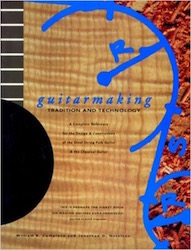
Guitarmaking: Tradition and Technology
by William Cumpiano and Jonathan Natelson
Hailed by Guitar Player magazine as “perhaps the finest book on guitars ever produced,” and by Booklistas “a Rolls Royce of construction guidebooks,” this impressive volume is the first book of its kind to describe in depth how both steel-string and classical guitars are actually designed and built. Over 450 photographs, drawings, and diagrams reveal in exquisite detail the hows, whys, and how-to’s of the traditional craft of guitarmaking, all accompanied by fascinating historical and technical notes. A comprehensive bibliography; a list of tools, materials, and supply sources; and a full index complete this uniquely authoritative reference–and essential acquisition–for guitar and craft enthusiasts, woodworkers, and students of instrument making everywhere. 392 pages. Published 1994. *Donated by Jim Ellsberry.
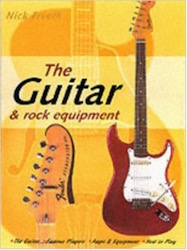
The Guitar & Rock Equipment
by Nick Freeth
The Guitar and Rock Equipment is a lively, comprehensive introduction to the instrument, its development, and its greatest exponents in rock and pop. It offers a wide range of basic information and practical guidance aimed at budding guitarists, but will also appeal to more knowledgeable music fans, who will value it as an authoritative, concise reference book. The book is divided into four sections. The first section provides descriptions and photographs of the most popular and influential acoustic and electric designs of the last 50 years. It includes a detailed overview of these instruments and focuses on important models in each category. Section 2 features biographies of some of the greatest guitarists of the last half-century and Section 3 examines amps and electronics–vital tools for any modern rock player. The types, brands and history of amps, speakers and stomp boxes are all described. The final section is an illustrated step-by-step guide to chords, finger positions and other elementary aspects of acoustic and electric guitar technique. 512 pages. Published 2002. *Donated by Jim Ellsberry
H
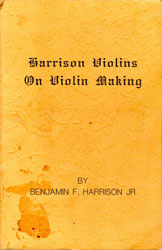
Harrison Violins On Violin Making
by Benjamin F. Harrison Jr.
An engineering approach to violin making. 172 pages, paperback. Published 1992. *Donated by the Southern California Association of Violin Makers.
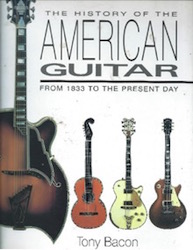
The History of the American Guitar, from 1833 to the Present Day
by Tony Bacon
A comprehensive visual tour of U.S. guitar history. Over 75 brand names are represented, with more than 300 guitars photographed. The bulk of the instruments illustrated were part of the celebrated collection of Scott Chinery, photographed before Chinery’s untimely death and the subsequent break-up of his unique collection. 148 pages. Published 2001. *Donated by Jim Ellsberry.
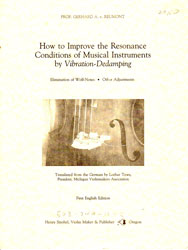
How to Improve the Resonance Conditions of Musical Instruments by Vibration-Dedamping
by Professor Gerhard A. von Reumont; translated by Lothar Tews
Elimination of wolf-notes and other adjustments. Translated from German. 64 pages, softcover, oversize. First English edition published 1996. *Donated by the Southern California Association of Violin Makers (SCAVM).
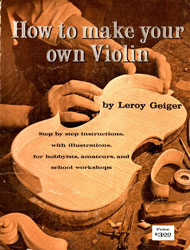
How to Make Your Own Violin: Step by Step Instructions With Illustrations For Hobbyists, Amateurs, and School Workshops
by Leroy Geiger
Self-explanatory. Ernst Heinrich Roth Company. 52 pages, softcover. Published 1963. *Donated by the Southern California Association of Violin Makers (SCAVM).
I
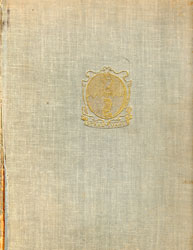
Italian Violin Makers (Revised Edition)
by Karel Jalovec
Self-explanatory. 444 pages, plus templates; hardcover (spine frayed), oversize. Published 1964. *Donated by the Southern California Association of Violin Makers (SCAVM).
J
K
L
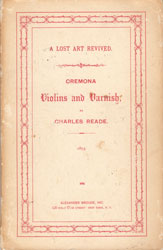
A Lost Art Revived: Cremona Violins and Varnish
by Charles Reade
Four letters descriptive of those exhibited in 1872, at the South Kensington Museum, etc. Reprinted from “The Pall Mall Gazette.” Alexander Broude, Inc. 37 pages, paperback. Originally published in 1890, this is a reproduction. *Donated by the Southern California Association of Violin Makers (SCAVM).
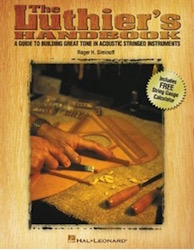
The Luthier’s Handbook: A Guide To Building Great Tone In Acoustic Stringed Instruments
by Roger H. Siminoff
An essential item for the instrument builder, The Luthier’s Handbook explores the secrets and science behind making good-sounding acoustic stringed instruments. Renowned author Roger H. Siminoff brings to the table more than four decades of luthiery experience and shares the time-tested philosophies, tips and technology of the craft. As the ideal complement to other books on building instruments, this text describes the structural and acoustical attributes of air chambers; what to listen for when tap-tuning; selecting a good piece of wood; placement of the braces and tone bars and how to tune them; how to select the right strings; what to consider in bridge design concepts; and much more. Includes a free String Gauge Calculator for determining the right set of strings. 96 pages. Published 2002. *Donated by Jim Ellsberry.
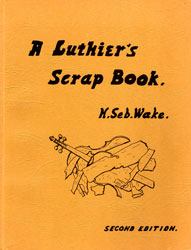
A Luthier’s Scrap Book (2nd Edition)
by H.S. Wake
A collection of short “how-to-do-it” articles pertaining to the making and restoration of violins, etc. Over 75 topics are covered. Illustrated with sketches by the author. 120 pages, softcover. Published circa 1970. *Donated by the Southern California Association of Violin Makers (SCAVM).
M
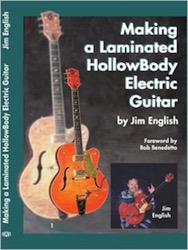
Making a Laminated Hollowbody Electric Guitar
by Jim English
This book will show you how to make a laminated archtop guitar. It can be done in a relatively small space, and does not require many tools or expensive machinery, just a desire to do it. It is written in an easy-to-understand format, with drawings and pictures accompanying step-by-step, easy-to-follow instructions. 173 pages. Published 2005.
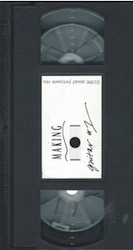
Making Guitar #1 (VHS cassette)
by Daniel Fort & Owen Riss
Details unavailable. Dust off the old VCR and find out what it’s all about! Running time unknown. Produced in 1990.
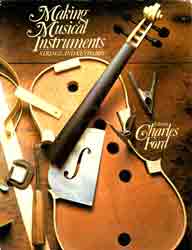
Making Musical Instruments: Strings and Keyboard
edited by Charles Ford
Collection of articles by various instrument makers and preservation experts on strings, including harpsichords. Pantheon. 192 pages, softcover. Published 1979. *Donated by the Southern California Association of Violin Makers (SCAVM).
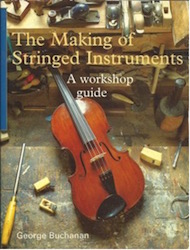
The Making of Stringed Instruments: A Workshop Guide
by George Buchanan
Experience the joy of making music in a whole new way—from choosing the wood to playing the last note. More than 500 illustrations and a straightforward text explain every stage of crafting stringed instruments, including detailed plans and instructions for constructing a violin, cello, jazz guitar, mandolin and more. A review from Library Journal states: “Experienced woodworkers who may be interested in making a stringed instrument such as a violin, guitar, or mandolin are the audience for this book, which is in no way a beginner’s guide to instrument making. The author uses the old European approach to tasks like carving, gluing, bracing, and finishing, so much so that the book might better be titled How To Make Instruments the Old-Fashioned Way. Times have changed, however, and instrument-making supply companies now offer a variety of purpose-built tools and woodworking supplies that greatly simplify and speed up the process described here.” 205 pages. Published 1989, Reprinted 2003.

The Making of Stringed Instruments: A Workshop Guide
by George Buchanan
Earlier edition of the same book listed above. Includes detailed plans for violin, classical guitar, jazz guitar, viola, cello, mandolin and mandola. 205 pages, hardcover. Published 1989. *Donated by the Southern California Association of Violin Makers (SCAVM).
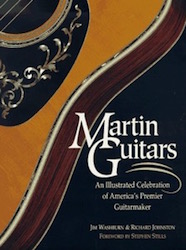
Martin Guitars: An Illustrated Celebration of America’s Premier Guitarmaker
by Jim Washburn and Richard Johnston
Founded in 1833, C.F. Martin and Company have made guitars used by performers such as Johnny Cash, Bob Dylan, Gene Autry, Joan Baez and Eric Clapton. This history of the company shows what makes the instruments special and includes interviews with rock, folk and country stars. “This book provides a terrific overview of the precious guitarmaking venture that my great-great grandfather started 165 years ago. It’s full of great guitars, never before released photos of the Martin family, and photos and interviews of the performers who made our guitars famous. Jim Washburn and Richard Johnston have caught the essence of the Martin story.” –Chris F. Martin IV, Guitarmaker. 264 pages. Published 1997. *Donated by Jim Ellsberry.
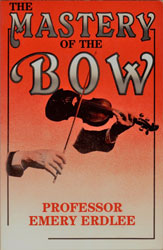
The Mastery of the Bow
by Professor Emery Erdlee
The author’s mission is to clear up many cloudy, misunderstood and confusing issues on the various approaches to the study of the technique of the bowing arm. Distinguished Publishing Corp., Fla. 168 pages, softcover. Published 1988. *Donated by the Southern California Association of Violin Makers (SCAVM).
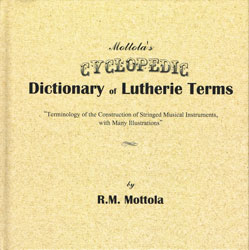
Mottola’s Cyclopedic Dictionary of Lutherie Terms
by R.M. Mottola
Lutherie is the term used to describe construction of stringed musical instruments such as the guitar, violin, mandolin and ukulele. A luthier is a person that builds stringed musical instruments. The dictionary provides conventional spelling and short descriptions of the most common terms used in modern lutherie as well as historical terminology that a modern luthier may come across in plans and other media. Luthiers, musicians, and others that read or write about stringed musical instrument construction will find it invaluable. Lutherie beginners who are attempting to navigate a mass of unfamiliar terminology will find the dictionary particularly useful. This is the first lutherie book you should buy. Planning on taking a course on building a guitar, ukulele or mandolin? Planning to build a guitar, ukulele or mandolin from instructions in a book or videos? Use of the dictionary will increase the rate of understanding for the new luthier. It is the perfect companion to instructional lutherie books, video and online lutherie courses, and lutherie school instruction. Conservatory and college music departments will want to add this reference to their libraries. Musical instrument retailers and manufacturers will find it to be invaluable. 181 pages, hardcover. Published 2020. *Donated by the author, R.M. Mottola.
N
O
P
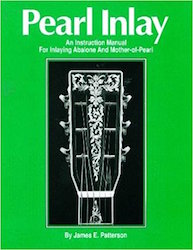
Pearl Inlay: An Instruction Manual For Inlaying Abalone And Mother-Of-Pearl
by James E. Patterson
The bible of pearl embellishment by James E. Patterson. This book has been the inspiration for generations of inlay artists. Reprinted from the original edition, it includes instructions for grinding, sawing, routing and gluing abalone and mother-of-pearl; making jigs for cutting dots, diamonds and strips; abalone purfling techniques, and tips on pearl engraving. 81 pages. Published 1991.
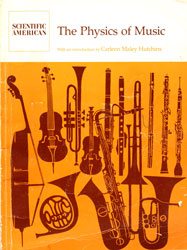
The Physics of Music
by Scientific American
Collection of articles from Scientific American magazine, concerning acoustic properties of varied instruments. 98 pages, softcover. Published 1978. *Donated by the Southern California Association of Violin Makers (SCAVM).
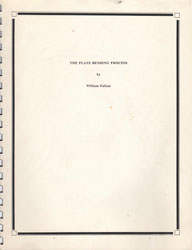
The Plate Bending Process
by William Fulton
Describes a technique for bending violin plates using green wood pressed into a jig and physically shaped with wedges. 8 pages, spiral bound. Self-published 1990. *Donated by the Southern California Association of Violin Makers (SCAVM).
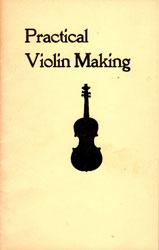
Practical Violin Making
by Edmond Fraser
Pamphlet on violin making, likely previously published in Popular Mechanics magazine. Pinch Penny Press. 24 pages. Published 1968. *Donated by the Southern California Association of Violin Makers (SCAVM).
Q
R
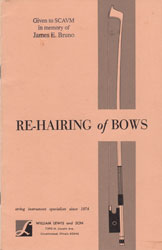
Re-Hairing of Bows
by Max Moller
Pamphlet on the re-hairing of violin bows, with photos. Missing top of pages 19-20. 20 pages. Reprint of an article from 1959. *Donated by the Southern California Association of Violin Makers (SCAVM).
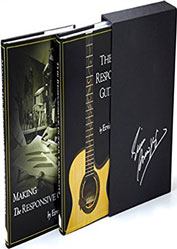
The Responsive Guitar (2-Book Boxed Set)
by Ervin Somogyi
The Responsive Guitar is about physics, dynamics, acoustics and construction of the guitar. It’s about the mechanics of tone; what materials to build with, when to add or remove wood for maximum benefit, and why those techniques work. Somogyi explains in exquisite detail how the guitar makes sound, and what musicians and luthiers need to know in order to appreciate a really well-made guitar. This book sets the foundation for the matching volume Making the Responsive Guitar. Making the Responsive Guitar is the second volume on a two-volume set of books that set out the principles and methods of building fine hand-made guitars. Where Volume 1 sets up the knowledge, this book is about how to build a guitar, from the very first step to the last. This limited edition, silver-embossed, facsimile-autographed slipcase holds both books. 342 pages and 284 pages. Published 2010.

A Review of Ancient and Modern Violin making
by W.W. Oakes
An often-reprinted classic on the subject. 113 pages, softcover. Published 1899, reproduction 1971. *Donated by the Southern California Association of Violin Makers (SCAVM).
S
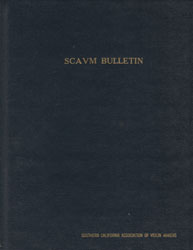
The SCAVM Bulletin (1964–2003)
various authors
An impressive seven-volume collection of articles and newsletters distributed by the Southern California Association of Violin Makers as The SCAVM Bulletin, covering the years 1964–2003. 1964 through 1995 are in six hard-bound volumes, and there is a soft-bound volume for the years 1996 through 2003. The bulletin contains many articles on violin-making technique and the technical aspects of lutherie, as well as the minutes and governance documents of SCAVM. *Donated by the Southern California Association of Violin Makers (SCAVM).
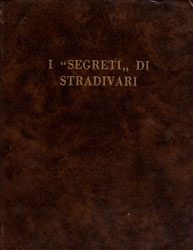
I “Segreti” di Stradivari (The “Secrets” of Stradivarius)
by Simone F. Sacconi
The “secrets” of Stradivarius, with a catalog of the relics of the “Ala Ponzone” Civic Museum in Cremona. Text, templates, photos of museum’s Strads. Libreria del Convegno. 261 pages, in Italian. Published 1972. *Donated by the Southern California Association of Violin Makers (SCAVM).

Sound Generation in Winds, Strings, Computers
by the Committee for the Acoustics of Music
Papers by various authors presented at seminars of the Committee for the Acoustics of Music, published by the Royal Swedish Academy of Music. Includes an inset 45 RPM vinyl record with sound samples. 245 pages, softcover. Published 1980. *Donated by the Southern California Association of Violin Makers (SCAVM).
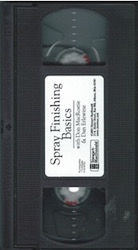
Spray Finishing Basics (VHS cassette)
with Don MacRostie and Dan Erlewine
A video tutorial on spraying a guitar finish, produced by Stewart-MacDonald. 115 minutes. Produced in 2001.
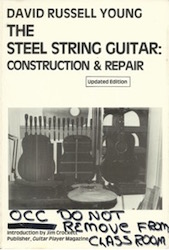
The Steel String Guitar: Construction & Repair
by David Russell Young
A complete guide to the craft, with clear, detailed instructions covering all the “hows” and “whys.” To give you a solid foundation in the fine art of handbuilding an instrument, David Russell Young shows you how to construct, step by step, one specific steel string guitar. He teachers a single, proven method—a method which he formulated during the construction of his own hundred-plus guitars. More than 150 photos and other illustrations go hand-in-hand with the text to detail minute stages of construction as well as to provide the needed overviews of the building process. A handy glossary and sources of supply listing are also included. You’ll be guided through such general areas as wood and binding selection, the top and back, building the rosette, fitting the truss rod, leveling the frets, finishing the wood, shaping the neck, carving the bridge, and much, much more. The end product of all this diligent work is something that neither the clear text nor the graphic photos can fully explain. Examine the edge binding and notice how even it is; inspect the guitar inside and note the cleanliness of the many glued joints; observe the smoothness and consistency of the highly polished finish. Then study the rosette, and find how even the mosaic is and how perfectly it fits into place; scan the instrument’s back to see how the two matched panels meet neatly at the center seam; notice the care with which the tuning keys were installed. Then, your first cautious tuning, an initial delicate strum followed by a more measured one—and you’ll know you’ve done it! And, can’t wait to begin work on number two. 160 pages. Published 1987.
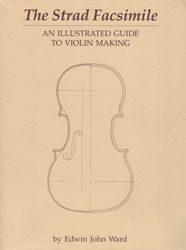
The Strad Facsimile
by Edwin John Ward
An illustrated guide to violin making in the Stradivarius tradition. 72 pages, with inset plans. Published 1992. *Donated by the Southern California Association of Violin Makers (SCAVM).
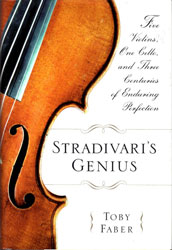
Stradivari’s Genius: Five Violins, One Cello, and Three Centuries of Enduring Perfection
by Toby Faber
This engaging appreciation celebrates the maestro’s legacy by following the adventures of six of his instruments. Faber begins with a short account of Stradivari’s life (1644–1737) and methods in the Italian city of Cremona, where violin-making techniques achieved their zenith. As the Cremonese violins passed through the hands of musicians, the instruments’ rich tone and penetrating sonic power stimulated a new style of virtuoso violin-playing that held Europe’s concert halls enthralled. And as time passed and the violins’ value soared, they spawned whole new industries in collecting, appraising, curating and faking them. Faber’s stylish account savors Stradivari’s marvelous acoustics and the individual personalities of his instruments while exploring the science behind them (X-rays, chemical tests and tree-ring analysis have all been deployed to unlock their secrets) and regaling readers with colorful tales of the musicians who built their careers around them. Random House. 264 pages. Published 2004. *Donated by the Southern California Association of Violin Makers (SCAVM).
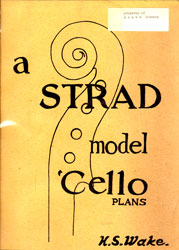
A Strad Model Cello Plans
by H.S. Wake
A set of seven full-scale working drawings (11″ x 40″ fold-outs) for a violoncello and the mold on which it is built. Together with plans (six 11″ x 17″ fold-outs) for a collapsible travel ‘cello. Softcover. Published 1975. *Donated by the Southern California Association of Violin Makers (SCAVM).

Structure and Preservation of the Violin
by Jacob A. Otto
The full title of this 150-year-old work is The Violin: A Treatise on the Structure and Preservation of the Violin and All Other Bow Instruments, Together With an Account of the Most Celebrated Makers, and of the Genuine Characteristics of Their Instruments. In the words of the author, “a minute description of the construction of the violin and all other bow-instruments, together with a careful explanation of the forms of the genuine Italian instruments, by which they may be clearly distinguished from the spurious imitations.” Sounds dense. New Temple Press, London. 90 pages. Originally published circa 1860. *Donated by the Southern California Association of Violin Makers (SCAVM).
T
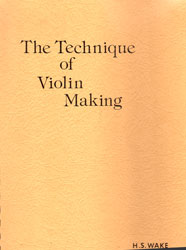
The Technique of Violin Making
by H.S. Wake
Describes the making of violins, including full size pattern. A basic step-by-step guide. 111 pages, softcover. Self-published 1973. *Donated by the Southern California Association of Violin Makers (SCAVM).
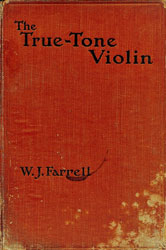
The True-Tone Violin
by W. J. Farrell
Author tries to replicate classical lutherie techniques at each step of the violin-making process, using methods current in 1921. Cassell and Co. Published 1921. *Donated by the Southern California Association of Violin Makers (SCAVM).
U
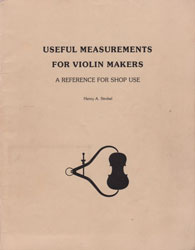
Useful Measurements for Violin Makers: A Reference for Shop Use
by Henry A. Strobel
Self-explanatory. Book 1 of the Strobel Series for Violin Makers. 42 pages, paperback. Self-published 1988. *Donated by the Southern California Association of Violin Makers (SCAVM).
V
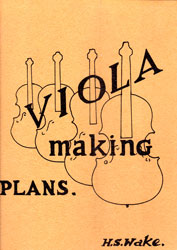
Viola Making Plans
by H.S. Wake
Comprising twenty full-scale working drawings (11″ x 24″ fold-outs) and descriptive text for viola making. Plans for the Tertis Model are also included. Some text, mostly drawings, templates, plans. Soft cover. Self-published 1976. *Donated by the Southern California Association of Violin Makers (SCAVM).
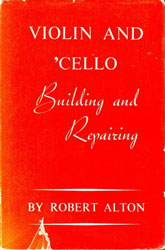
Violin and ‘Cello: Building and Repairing
by Robert Alton
Reprint of a 1946 text on—you guessed it—building and repairing violins and cellos. 182 pgs, hardcover. Published 1969. *Donated by the Southern California Association of Violin Makers (SCAVM).
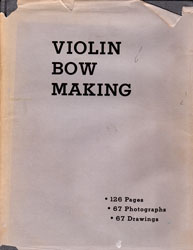
Violin Bow Making
by John Alfred Bolander, Jr.
Self-explanatory. Hardcover, oversize, 126 pages, 67 photographs, 67 drawings. Boyd Poulsen Violin Shop, San Mateo. Published 1969. *Donated by the Southern California Association of Violin Makers (SCAVM).
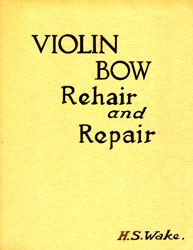
Violin Bow Rehair and Repair
by H.S. Wake
The complete violin shop guide to proper bow maintenance. Step-by-step, with inset templates. 93 pages, softcover. Self-published 1975. *Donated by the Southern California Association of Violin Makers (SCAVM).

Violin: Details for the Maker
by Robert George
A guide to violin making written by Whittier, California-based violin maker Robert George. 51 pages, spiral bound. Self-published 2007 *Donated by the Southern California Association of Violin Makers (SCAVM).
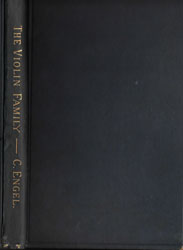
The Violin Family
by Carl Engel
The full title of this 135-year-old text is Researches into the Early History of the Violin Family. Interior pages have mottling spots. Lovello, Ewer & Co. 168 pages. Originally published 1883. *Donated by the Southern California Association of Violin Makers (SCAVM).
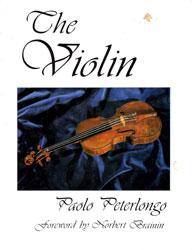
The Violin: Its Physical and Acoustic Principles
by Paolo Peterlongo
A scientific analysis of the instrument. Translated from the Italian text Strumenti ad arco: Principi fisici del loro funzionamento. 160 pages, hardcover. Originally published 1973. First English edition published 1979. *Donated by the Southern California Association of Violin Makers (SCAVM).
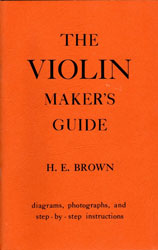
The Violin Maker’s Guide
by H.E. Brown
Diagrams, photos and step-by-step instructions for making violins. Softcover pamphlet. Includes a folded template for a Stradivarius model violin. International Guitar and Import Co. 52 pages. Published 1974. *Donated by the Southern California Association of Violin Makers (SCAVM).
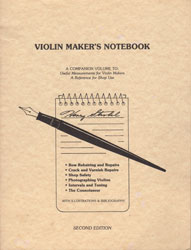
Violin Maker’s Notebook (2nd Edition)
by Henry Strobel
Companion volume to Useful Measurements for Violin Makers (also in our library). A shop reference manual. Chapters on bow rehairing and repairing. Repairing and retouching cracks in instruments. Workshop safety. Instrument photography. Musical intervals. Now contains an illustrated chapter showing the repair of a fine violin smashed in a car crash. 66 pages. Published 1991. *Donated by the Southern California Association of Violin Makers (SCAVM).
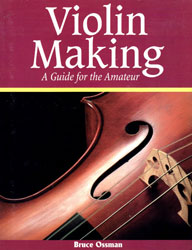
Violin Making: A Guide for the Amateur
by Bruce Ossman
An excellent book, even for the beginner. Very comprehensive, detailed information and drawings. Easy-to-follow instructions. Great from choice of wood to finished product. Fox Chapel. 68 pages, softcover. Published 1999. *Donated by the Southern California Association of Violin Makers (SCAVM).
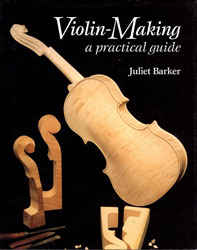
Violin-Making: A Practical Guide
by Juliet Barker
Violin-Making enables anyone, whether a beginner or a skilled woodworker, to follow in the tradition of the Italian masters and, literally, make their own music. The book includes a short history of violin making; an introduction to materials, design, and techniques; chapters on each stage of making a violin, from the rib structure to varnishing and stringing the instrument; tables of measurements, including violins, violas, and cellos from quarter to full size; and 200 clear color photos and diagrams. Juliet Barker trained at the Bavarian School of Violin Making; she is a professional violin maker, restorer, and teacher. 125 pages. Published 2001. *2 copies available.
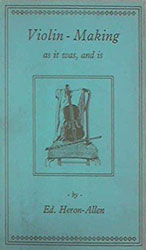
Violin-Making: As it Was, and Is
by Edward Heron-Allen
The full title of this 130-year-old text is Violin-Making: As it Was, and Is: Being a Historical, Theoretical and Practical Treatise on the Science and Art of Violin-Making, for the Use of Violin Makers and Players, Amateur and Professional. With 200 illustrations. Dedicated to the Duke of Edinburgh. Whitefriars Press (Great Britain). 352 pages, hardcover. Originally published 1885, reprinted 1973. *Donated by the Southern California Association of Violin Makers (SCAVM).
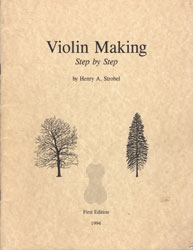
Violin Making: Step by Step
by Henry A. Strobel
Book 5 of the Strobel Series for Violin Makers. A complete, traditional method. Includes brief descriptions of alternate methods. Photo-illustrated, from sharpening tools to varnishing and adjustment. Includes full size drawings for making a Stradivari model violin. Illustrated with 115 photographs of the model violin (Leandro Bisiach), and of the demonstration violin as it was made, step by step, by Henry Strobel. For the beginning or advanced maker or the interested violinist. 78 pages, paperback. Self-published 1994. *Donated by the Southern California Association of Violin Makers (SCAVM).
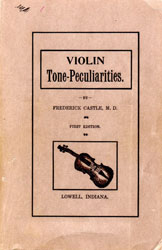
Violin Tone-Peculiarities
by Frederick Castle, M.D.
This 112-year-old text was originally conceived as a series of lectures, addressed to an imaginary audience of violin students, written for and partly published in The Western Musician musical journal out of Dixon, Illinois. 307 pages, softcover. Originally published 1906. Reprinted 1988. *Donated by the Southern California Association of Violin Makers (SCAVM).
W
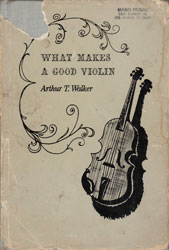
What Makes a Good Violin
by Arthur T. Walker
Beats me! Read this, and maybe you’ll find out. Pageant Press. 79 pages, hardcover. Published 1960. *Donated by the Southern California Association of Violin Makers (SCAVM).
X
Y
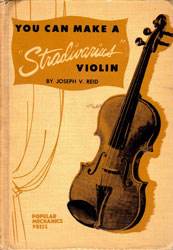
You Can Make A Stradivarius Violin
by Joseph V. Reid
Just believe in yourself! Popular Mechanics Press. 47 pages, hardcover. Plans pull out. Published 1950. *Donated by the Southern California Association of Violin Makers (SCAVM).
Z
Become A Member
Membership sign-ups for 2023 are temporarily on hold, pending an association vote on a membership dues increase. Voting will take place the final week of December 2022. We expect to have the new membership system up and running within the first two weeks of January 2023. Thank you for your patience!
